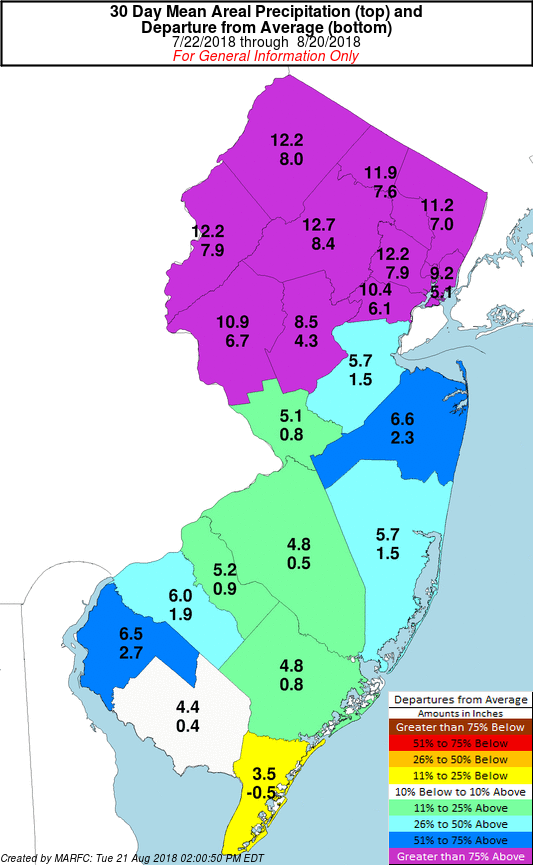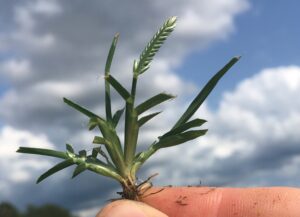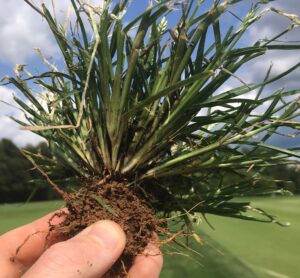Main Content
The summer of 2018 isn’t going away quietly for many in New Jersey. August 2018 will be remembered for a steady dose of torrential rain that has made turfgrass management extremely difficult, especially in the northern half of the state. In the last 30 days, over 12 inches of rain have fallen across several counties in Northern NJ. This is almost triple the 30-year average of approximately 4 inches of rain for this period in a normal year.

These rains have produced saturated soils during an already difficult time of year for cool-season turfgrass (examined by Dr. Murphy in a previous post). High humidity and extended periods of leaf wetness have provided ideal conditions for diseases as well. Desirable turfgrass is thinning out and giving the competitive advantage to certain weeds. If you have weed problems right now you are not alone!
Nutsedge, false-green kyllinga, and creeping bentgrass (where it is a weed in poorly drained areas) are very competitive perennial weeds in wet soils and I’ve noticed they have become more prevalent in recent weeks. Even roughstalk bluegrass has awoken from summer dormancy in some spots.
Amongst annual weeds, crabgrass and goosegrass seem to be especially prevalent this year. Plants that escaped pre-emergence applications matured very rapidly through warm and wet conditions in late July through mid August and made post-emergence control difficult. Crabgrass and goosegrass are much more difficult to control as they mature beyond the 5-7 tiller stage of growth. With heavy rainfall and warm temperatures in late July it was difficult if not impossible to make post-emergence applications in time for optimal weed control.


In a perfect world, post-emergence herbicide applications are not necessary due to an effective pre-emergence herbicide program. But grass, soils, and weather are not perfect and pre-emergence breakthrough in problem areas is expected. Pre-emergence herbicide programs were pushed to, or past the limit after heavy rainfall this spring. Late May was especially wet in the Central NJ where some areas received almost 10 inches of rain which fell during 11 days of a 17-day period (see CoCoRaHS for statewide maps). These conditions may have increased dissipation of pre-emergence herbicides, especially in sandy soils. Crabgrass breakthrough may be especially evident on slopes, high traffic areas, compacted soils, or where only a single pre-emergence application was made. Research consistently demonstrates that split application pre-emergence programs provide better crabgrass control than a single application and we are seeing history repeat itself in our 2018 crabgrass trials. Split application programs are providing excellent crabgrass control, and two most common pre-emergence herbicides (dithiopyr and prodiamine) are providing the same amount of crabgrass control at both locations. Keep in mind that in our research trials we subject herbicides to intense weed pressure, but the herbicides are applied uniformly under ideal conditions (immediate post-application irrigation, clipping return, non-compact soils) so we can make comparisons amongst treatments. Real world conditions may not be so ideal.


Moving forward
Apply post-emergence herbicides if possible. Weed suppression that limits seed production is especially worthwhile on and around high-value sites (e.g., putting greens, athletic fields). Pylex (topramezone) is an excellent option for goosegrass control and crabgrass suppression in cool-season turfgrass. In my experience, applications at 1.0 to 1.5 fl oz/A will control multi-tiller plants (only 0.25 oz/A is permitted in creeping bentgrass). Tank-mixtures of Pylex and SpeedZone also provided excellent goosegrass control in our 2018 research. This tank-mixture will be evaluated more in 2019 as an option in Kentucky bluegrass, perennial ryegrass, and tall fescue. Quinclorac products (Drive XLR8, Solitare, generics) that can be applied at up to 0.75 lbs quinclorac/A are more effective than Pylex on crabgrass in cool-season turfgrass (lower rates can be used in creeping bentgrass) but will not control goosegrass. Tank-mixtures of Drive XLR8 and Pylex are safe to Kentucky bluegrass, tall fescue, and perennial ryegrass in my experience. Acclaim Extra (fenoxaprop) is another good option that will provide multi-tiller crabgrass and goosegrass control at higher rates. See product labels for more information on turfgrass tolerance, tank-mixtures, and weed control efficacy. Be sure to read the label carefully for information on adjuvants. Not including an adjuvant, or using the wrong one will severely reduce the efficacy of many post-emergence herbicides. For even more information, an excellent guide for weed ID and herbicide selection can be found here at the Purdue University Bookstore. I highly recommend this comprehensive guide.
More importantly, use fertilization and cultural practices to encourage recovery of the cool-season turfgrass once temperatures are more favorable and cool-season grasses regain the competitive advantage (hopefully around labor day). A strong stand of turfgrass will be more competitive against winter annual weeds and crabgrass in 2019. Even in cases of severe crabgrass or goosegrass infestation, a total kill of the existing turfgrass stand is usually not necessary if there is a good base of desirable turfgrass lurking beneath the crabgrass. Use selective herbicides, seed, cultural practices, fertilizer, and September weather to your advantage.